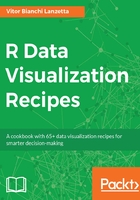
There's more
To have data coming solely from data frames is a strong restriction, but it does obligate the user to be explicit about the data and also draw a very clear line on what is ggplot2's concern (data visualization) and what is not (model visualization). In order to avoid headaches that come from downloading spreadsheets, setting up working directories, and loading data from files, we're taking an alternative way: getting data from packages instead.
data.frame() may be the most convenient function to coerce vectors into data frames in R.
By doing this, we ensure that the readers only need to reach the R's console to reproduce recipes; we want nothing to do with web browsers (we're too cool for school, school meaning web browsers). We shall follow this approach to the end of the book. This recipe look over datasets base packages to do so. ggplot2 has some data frames of its own.
Enter library(help = 'datasets') to general information on the other data sets.
It's also important to outline that the gg in the ggplot2 and ggvis refer to the Grammar of Graphics. That's a very important and inspiring theory that in had influenced ggplot2, ggvis, and plotly. The layered/iterative way that these packages handle plots might come from the Grammar of Graphics and makes graphics building much easier and reasonable. Learning this theory may give you heads into the process of learning these packages while learning these packages may give you heads when it comes to learn the Grammar of Graphics.